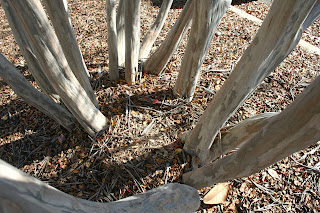


The morning of the presentation, I helped set up our installation. We tried to clear away the messy leaves and straw from the path to better show it and ended up with more stepping stones than we needed!
I think that the open critique and presentation went well. Along with my section and plan drawings of a couple of the stones that I made, I was in charge of the Oasis blog with help from Hannah. I documented our process with photos from each day, each experiment, each failure, each success, and each idea in order to explain our work.
Our guests walking through the oasis brought up things like considering how much the stones will set in the ground - if we need to actually dig a little to place them down in the ground or to just let them settle themselves. The question about where the circle and square idea came from. Most caught onto the squares relating to the parking spaces and building, but some questioned the circles relating to the ventilation tower, the light posts, the trees, and the curves of the islands. But everyone had something good to say about our design. They all liked the outlining of the path rather than a literal path, some called it clever.
I though our inside presentation turned out good as well. The models looked nice, the photos and drawings gave a lot of information, and our oasis leader, Cassandra, did a very good job as a part of the class presentation group.





























